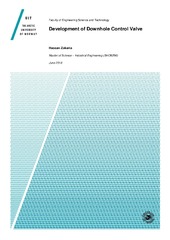| dc.contributor.advisor | Polanco Pinerez, Geanette | |
| dc.contributor.author | Zakaria, Hassan | |
| dc.date.accessioned | 2020-06-02T09:58:48Z | |
| dc.date.available | 2020-06-02T09:58:48Z | |
| dc.date.issued | 2018-05-31 | |
| dc.description.abstract | Designing for downhole environment is a challenging process. High pressure and temperature are the main well conditions that effect the design decisions and the tool geometry. Also, the well fluids can obtain high concentration of corrosive content such H2S acid that plays major role in material selection.
The intention of this study is to develop Downhole Control Valve that can be connected to plug and packers system, where the valve should be controlled remotely from the wellhead without the use of well intervention methods. Avoiding the use of well intervention will reduce cost and optimize operation time.
Using the design process, the valve evolved from the idea, design requirements, the concepts development, concept selection, hand sketches, 3D CAD modelling, calculation, FEA simulation, CFD simulation, material selection and finally to prepare the model for prototype manufacturing.
This master thesis describes in detail the design process stages of Downhole Control Valve and as result, a unique solution of the valve has been achieved where the valve is designed to be exposed to high concentration of corrosive fluids at high pressure and temperature. The valve is activated and controlled from the wellhead by applying the pressure on top of it. The activation pressure can be adjusted by using calculated number of screws and allows internal sleeve in the valve to open the inlet flow ports. The material selection of the valve was based on traditional material that is commonly used in the industry standard.
The study definitively provides reliable solution of the design considering the harsh environment that will be exposed to.
The calculation used in the study provides the initial understanding of the future development. In the further research on the valve it is recommended to have more in depth CFD simulation for the design optimization. | en_US |
| dc.identifier.uri | https://hdl.handle.net/10037/18412 | |
| dc.language.iso | eng | en_US |
| dc.publisher | UiT Norges arktiske universitet | en_US |
| dc.publisher | UiT The Arctic University of Norway | en_US |
| dc.rights.accessRights | openAccess | en_US |
| dc.rights.holder | Copyright 2018 The Author(s) | |
| dc.rights.uri | https://creativecommons.org/licenses/by-nc-sa/3.0 | en_US |
| dc.rights | Attribution-NonCommercial-ShareAlike 3.0 Unported (CC BY-NC-SA 3.0) | en_US |
| dc.subject.courseID | SHO6266 | |
| dc.subject | VDP::Teknologi: 500::Industri- og produktdesign: 640 | en_US |
| dc.subject | VDP::Technology: 500::Industrial and product design: 640 | en_US |
| dc.subject | Downhole Control Valve | en_US |
| dc.subject | CFD | en_US |
| dc.subject | FEA | en_US |
| dc.subject | Well intervention | en_US |
| dc.title | Development of Downhole Control Valve | en_US |
| dc.type | Master thesis | en_US |
| dc.type | Mastergradsoppgave | en_US |


 English
English norsk
norsk
